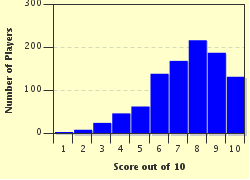Quiz Answer Key and Fun Facts
1. Where on your body would you find your philtrum?
2. Which one of these people would be most likely to have a fontanel?
3. If you hurt your hallux, which part of your body is causing you pain?
4. In what funny spot is your olecranon located?
5. Which part of your body has a part called an areola?
6. If I wanted to see your palatine uvula, what would I ask you to do?
7. Sometimes used for identification purposes, where would you find your pinna?
8. The proper term for a dimple in the chin is an ephelis.
9. On which part of your anatomy would you find your lunula?
10. Phalanges is an anatomical term for the bones of your fingers and toes.
Source: Author
dcpddc478
This quiz was reviewed by FunTrivia editor
CellarDoor before going online.
Any errors found in FunTrivia content are routinely corrected through our feedback system.


